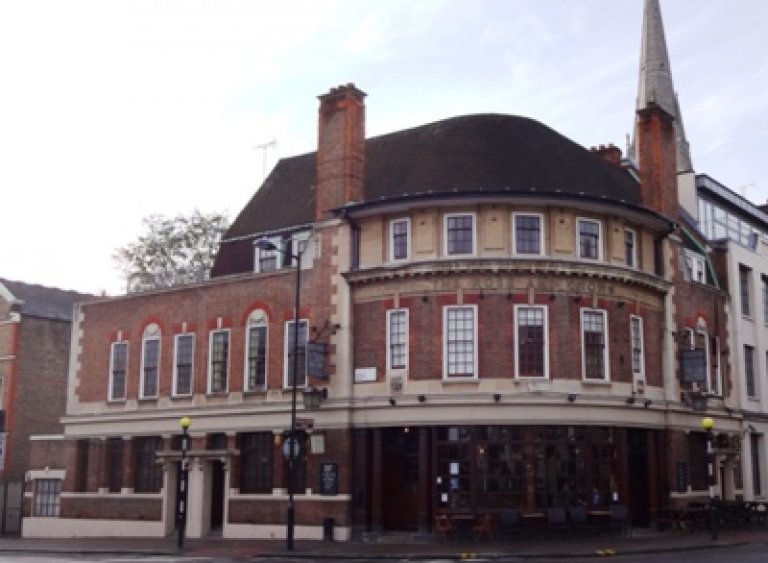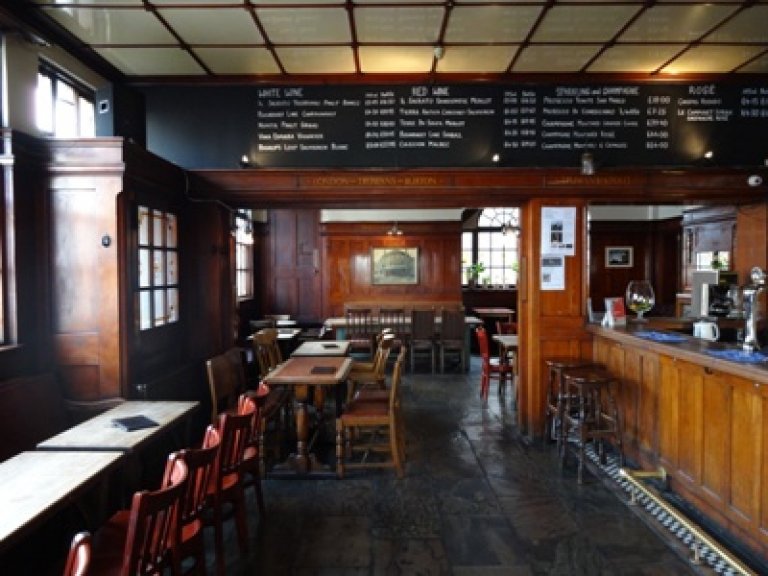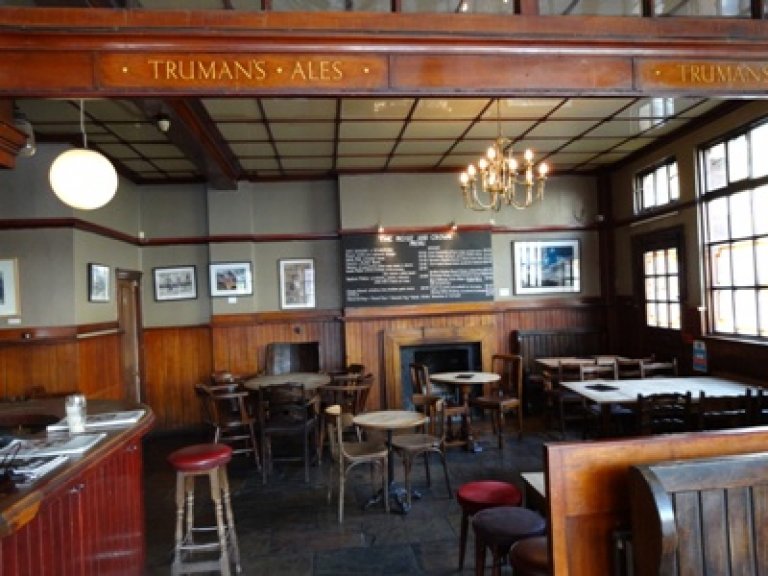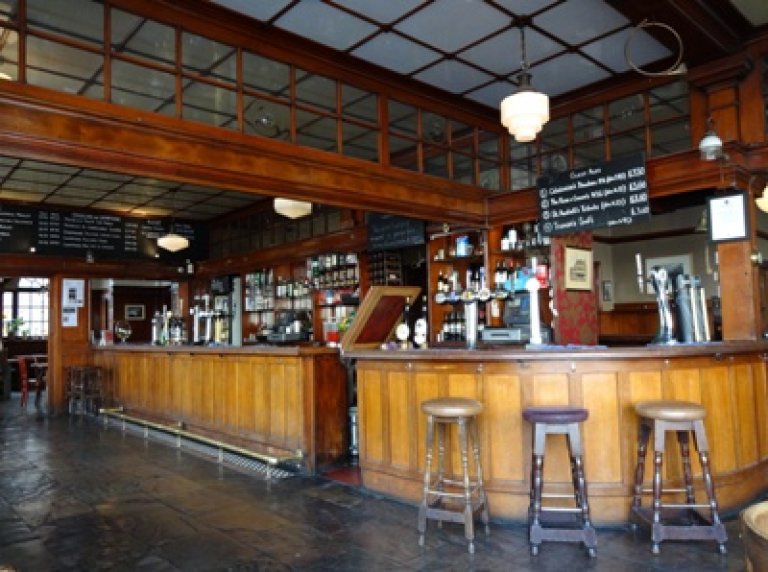Rose & Crown
199 Stoke Newington Church Street, Stoke Newington, N16 9ES
Like the Beehive, this pub is not only a grade II listed building but it is also on CAMRA’s London Regional Inventory and the description is as follows: “An ambitious Truman’s pub of 1934 that sweeps elegantly round a corner. Exterior features to note are the lamps, a pair of fine metal inn signs, and glazed shop-window to display wares from the former off-licence. You can also trace the sequence of original rooms in the metal signs over the doors: right to left – public bar, private bar, outdoor sales, saloon and lounge. Internally there is still a good feel of the 1930s layout since the screens dividing the various rooms survive in their upper parts. Also the detailing of the counter is different in the public bar area from the private bar and, unlike the rest of the pub, the lounge part has hatch-style service. Do have a look at the light-shades. Extraordinary as it may seem, these appear original and different parts of the pub have different-shapesd shades. The panelled interior is in classic Truman’s style in of the 1930s. Characteristics involve advertising lettering on the panelling naming some of the brewery’s offerings, the chequered spittoon trough, light-cream-coloured Vitrolite panels in the ceiling, overmantels with Truman’s mirrors inserts, and doors in the bar counter to get at the beer engines. Note also some of the chairs which are not unlike the 1930s survivors at the Fox and Pheasant, West Brompton, SW10. The heavy-handed ‘stone’ flooring is clearly a product of the opening up of the pub. If heading for Stoke Newington High Street, the Rochester Castle near the top end (no. 145) is worth a look for late Victorian tiling near the entrance and a skylight towards the rear.”
The listing description is as follows: “An 'improved' public house of 1930-32, designed by A E Sewell for Trumans, Hanbury and Buxton Ltd.
Reasons for Designation The Rose and Crown public house, Stoke Newington, built in 1930-32 to the designs of A E Sewell for Trumans, Hanbury and Buxton Ltd is listed at Grade II for the following principal reasons: * Architectural interest: an ambitious, architecturally accomplished Neo-Georgian design by Truman’s principal architect, A E Sewell, who has a number of listed public houses of this date to his name; * Materials: the skilful deployment of good quality materials to the exterior, including iron work by Morris Singer Co.; * Interior: the clear legibility of Sewell’s sophisticated plan-form and survival of important features including the servery counters, bar-back, Vitrolite ceiling, timber panelling, fireplaces and lighting; * Group value: with numerous listed buildings including the Grade II* Church of St Mary and the Grade II Town Hall.
History Inter-war ‘improved’ or ‘reformed’ pubs stemmed from a desire to cut back on the amount of drunkenness associated with conventional Victorian and Edwardian public houses. Licensing magistrates and breweries combined to improve the facilities and reputation of the building type. Improved pubs were generally more spacious than their predecessors, often with restaurant facilities, function rooms and gardens, and consciously appealed to families and to a mix of incomes and classes. Central, island serveries with counters opening onto several bar areas allowed the monitoring of customers and also the efficient distribution of staff to whichever area needed service. Many, although not all, of the new pubs were built as an accompaniment to new suburban development around cities, and a policy of ‘fewer and better’ was followed by magistrates both in town and on the outskirts. A licence might be granted for a new establishment on surrender of one or more licences for smaller urban premises. Approximately 1,000 new pubs were built in the 1920s – the vast majority of them on ‘improved’ lines - and almost 2,000 in the period 1935-39. Neo-Tudor and Neo-Georgian were the favoured styles, although others began to appear at the end of the period.
The Rose and Crown public house was built in 1930-32 to the designs of A E Sewell (1872-1946), principal architect for the east London brewers Truman, Hanbury, Buxton and Co. Ltd., founded in c1666. Former public houses of the same name are known to have existed on Church Street from approximately 1612, but historic mapping suggests that these were located on the opposite (east) corner of Albion Road. This area of Stoke Newington is characterised by C19 development of terraces and shops and as a result of increasing motor traffic a road widening scheme was instigated by the Metropolitan Borough of Stoke Newington in 1930. A number of buildings, including the former Rose and Crown, were demolished and a new pub was built on a prominent corner plot on the west side of Albion Road at the reconfigured junction with Church Street. Drawings of the elevations and floor plans as built survive and the pub featured in an article of the national journal ‘The Brick Builder’ in June 1932 as an example of Sewell’s work. It is also mentioned in Basil Oliver’s seminal text 'The Renaissance of the English Public House' (1947) and more recently it has featured in Geoff Brandwood and Jane Jephcote’s book 'London Heritage Pubs, An Inside Story' (2008). The Rose and Crown appears on CAMRA’s national inventory as having a historic interior of regional importance.
There have been some alterations. Externally, two entrances on the Albion Road elevation have been replaced with a single window and internally the separate bars have been opened up to form one large space resulting in the loss of the partitions. The former restaurant/club room on the first floor has been converted into a guest house suite and breakfast room. The room above the curved entrance range is a modernised flat for staff. The second floor rooms form part of the guest house; a roof terrace has been established on the flat roof at the south-east end. All of the guest house accommodation has modern panelling, fixtures and fittings.
Details A public house of 1930-32, designed by A E Sewell for Trumans, Hanbury and Buxton Ltd, on a prominent corner plot. The decorative wrought iron work is by Morris Singer Co.
MATERIALS Red brick with stone dressings and a tiled roof.
PLAN The pub is built on a corner plot and has a central, curved façade. Internally, the ground floor of the pub was originally divided into five separate areas (public, private, off-sales, saloon and lounge/dining room) as indicated on the ground floor plans of 1930, all served by a central rectangular servery. On the west side of the Stoke Newington Church Street elevation there was a private area and staircase leading to the first floor for the Landlord and staff. The kitchen was on the first floor.The bar partitions have been removed to create a single open bar.
EXTERIOR The Rose and Crown is Neo-Georgian in style, though its asymmetrical massing owes something to Arts and Crafts design. The main curved section of the pub is of three storeys, while the elevations facing Albion Road and Stoke Newington Church Street have two storeys in addition to recessed attic levels. The ground floor has a number of entrances which historically led to the individual bars. That on the north served the public bar, while adjacent to this, on the right of the curved part of the pub’s frontage, was the entrance to the private bar. On the left (south) of the showcase window was the off sales or outdoor department, and to the left of this, opening from Albion Street, were paired entrances to the saloon bar and the ‘lounge and dining room’ (so named on the ground-floor plans of 1930).
The central curved façade is the primary focal point of the Rose and Crown, with the five first-floor windows framed by ashlar quoins on the upper levels being capped by a pair of large brick chimneystacks, rising to the height of the tall roof with its original plain tiling, following the curve of the corner. At the ground floor, the private bar – which along with the off sales compartment occupied this corner portion of the pub – is the most detailed element of the ground-floor arrangement, featuring large multi-paned windows with dimpled glass which served as a central showcase to display the brewery’s beers on offer inside. Two entrance vestibules are set either side of this central curved window, serving the former private bar (on the west) and the outdoor or off sales department (on the south-east); both entrances retain their cast-iron name plates with carved wooden surrounds. Each is flanked by a pilaster and a pair of elegant wooden Doric columns. Set between these columns, forming the upper part of the entrance ways, are panels of wrought ironwork and behind these, further wrought iron fanlight screens all by Morris Singer Co., a notable art foundry responsible for casting Sir Edwin Landseer’s four monumental lions at Trafalgar Square.
The compact frontage facing Church Street, to the right of the curved central façade, contains the entrance to the public bar. The ground floor has a small entrance door off-set to the right (west) of this frontage, positioned beneath a projecting canopy supported by scroll brackets. The door retains its original glazing, and also its original brass plate bearing the name of the public bar. To the left is a large multi-paned window with decorative yellow bordering on the glass. The door and window are flanked by brick pilasters with stone dressings.
The frontage facing Albion Road is the widest of the Rose and Crown’s elevations, formed of seven bays with an additional single-storey projection at the pub’s southern end. The arrangement of the ground floor follows the pattern of that on Church Street, having multi-paned windows with decorative yellow-bordered glass divided by brick pilasters, though here these are set either side of the centrally grouped pair of entrance doors, leading to the formerly separate saloon bar and lounge and dining room. The single-storey projection at the end of this section originally contained two doorways, that on the right leading via a passageway to the rear yard and that on the left providing entrance to a public urinal. These two doors have now been replaced by a single large window. Singer also manufactured the highly unusual pair of metal inn signs at first-floor level, hung from wrought iron brackets on each side of the pub’s central elevation. Beneath there are original glazed lamps, added in c1932.
The first floor throughout forms a piano nobile, and features a symmetrically arranged assortment of sash windows, most set beneath red brick lintels with stone keystones. Further decorative treatment at the corner portion of the pub takes the form of two small sculptural relief panels depicting a rose and a crown at first-floor level, beneath the narrower and shorter sash windows at either side of this central elevation. At first-floor level on the Church Street frontage there is a large Venetian window with a swag motif set in the central tympana. Above this is a short parapet, which rises to meet the chimneystack to the left (east) side of this frontage, with a carved festoon marking this transition, this arrangement being symmetrically repeated on the pub’s Albion Road side. Here six sash windows light what were formerly the club room, dining room and staff room. The windows have red brick lintels inset with keystones, the exceptions to this being the second and fifth windows (as read from the south), which have arched tympana containing swag motifs. Ashlar quoining capped with a decorative carved festoon terminates the first-floor elevation at the southern end of the Albion Road frontage.
The first floor is divided from the second by a stone band bearing carved letters giving the pub’s name, with a cornice above. The second storey is entirely clad in stone and is approximately half the height of the first; rectangular panels divide the short sash windows. The roofline of the second floor continues along the elevation for three bays, leaving a flat roof for the remaining section, now in use as an open terrace.
INTERIOR The interior of the Rose and Crown is notable in being amongst the most complete examples of the Truman’s inter-war ‘house style’, with features such as original fireplaces, branded mirrors, decorative glazing and chequer-work tiling along with inlaid oak panelling and bar back fittings bearing advertisements for the brewery’s 1930s beers. Integrated within the bar-back is a dumb-waiter. The bar counters are original throughout, all retaining distinctive hinged doors for maintenance access and chequer-tiled borders with brass foot rails, with original bar backs set parallel behind the counters. A particular feature of note internally is the Vitrolite panelled ceiling, which is complete in all of the public rooms in the pub. A further survival, as seen in the private bar, off sales compartment, saloon bar, and lounge and dining room, are what appear to be the original hanging light fittings, these being recorded in an inventory of furniture and effects of January 1935.
Although the bar divisions have been mostly removed their glazed upper portions survive marking their positions; the original fittings and fixtures appropriate to each of the bars survive well. These include original fireplaces in the public bar, bar counter in the private bar, brass lamp to the off-sales, counter, panelling, back bar and fireplace in the saloon bar. In the lounge and dining room, the upper portion of the original partitions, doors, fireplace, counter and gaslight on a lamp fixture remain. At the south-east corner of the pub, a door marked as 'restaurant' led to the first floor club room; the stairs remain but no longer lead to the first floor. The club room is now a guest suite, and the dining room is a breakfast room for guests. In both rooms there are two fireplaces with tiled surrounds; the panelling is modern but incorporates some of the carved timber panels advertising the brewery. The back stairs have simple balusters and newel posts with ball finials and a curved timber handrail attached to the wall through brass fittings. The lettering which once adorned the exterior of the curved corner is now relocated on the first floor landing wall.
Selected Sources Books and journals Brandwood, G, Jephcote, J, London Heritage Pubs - An Inside Story, (2008) Campaign for Real Ale Pub Heritage Group, , The CAMRA National Inventory: Pub Interiors of Outstanding Historic Interest, (2003) Cole, Emily, The Urban and Suburban Public House in Inter-War England, 1918-1939’, Historic England Research Report Series, no. 4/2015, (2015) Oliver, B, The Renaissance of the English Public House, (1947) 'The Tavern Beautiful' in The Brick Builder, (), 38-40”
The WhatPub link is here: WhatPub/Rose & Crown
The Rose & Crown featured on the Daytime Crawl of North London in October 2005, the Going South in the North: Daytime Crawl from Stoke Newington to Hoxton in August 2010, and the Ant and Bee: Daytime Crawl of Tottenham and Stoke Newington in February 2016.




